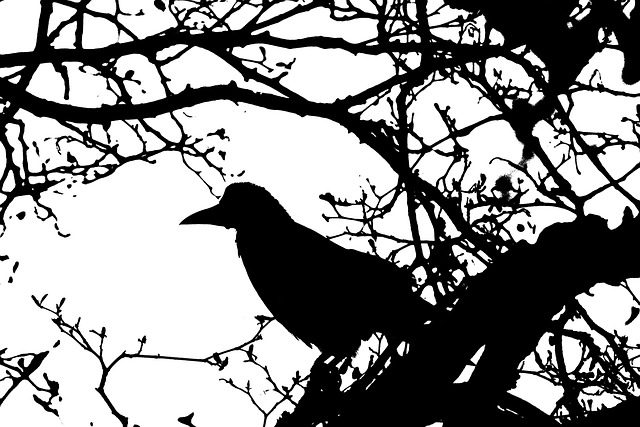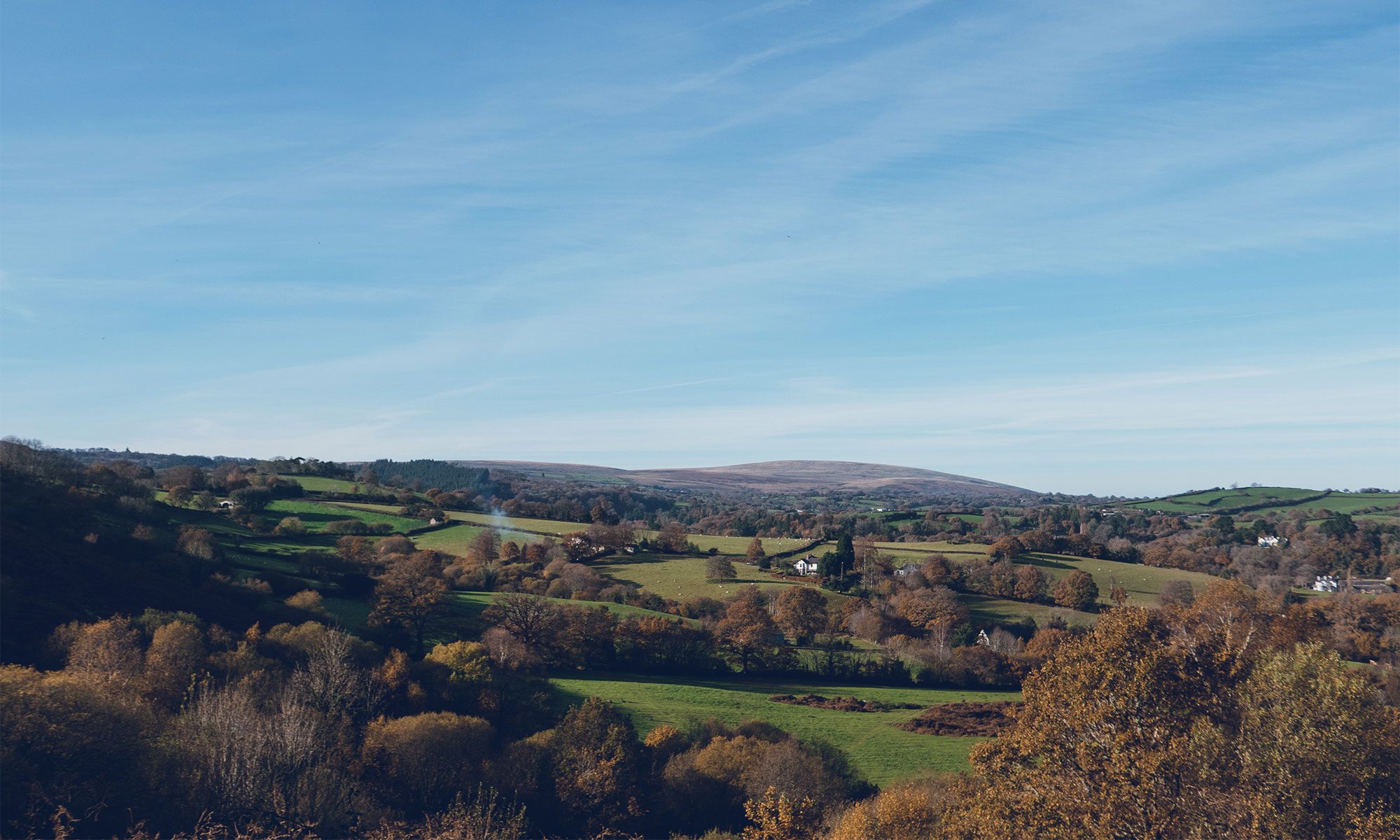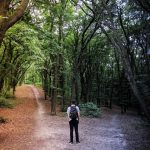
Cronk cronk… Cronk cronk… Cronk cronk…
At the third of the rhythmic set of cries I stop, push the garden fork into the soil and turn. Of course, I know it’s a rook, but somehow there’s a depth in this particular call that makes the familiar strange, she has my attention. The tone and the rhythm have drawn me out of myself, out of the business of preparing ground for spring planting.
I scan the still-bare trees at the edge the allotments looking for the owner of this loud but surprisingly warm, almost mellow voice. Behind the trees the sky is empty, a cloudless, bottomless blue. I stand, squinting into the brightness, quiet, waiting. One patient breath; another, two more, long and slow. Then a rolling shuffle along a high branch catches my eye; there, I see you now. Out of the seamless ground of sky and woods where ‘rook’ is simply part of everything, a figure is pulled out by my curious senses and insistent urge to know and name. Then, almost as if she knows she’s been spotted, she takes flight, air whistling whhsh-whhsh-whhsh through beating black wings, heading towards the rookery above the nearby cemetery.
Left behind, I close my eyes for a moment, listening to the presences of this place. Over there high in the cherry, intense, confident warbling of a robin; somewhere to my left , darting between the cover of the beech hedge and bramble brash, a whirr of wren’s wings; very close to my ear the drone of a bumble bee. From the direction of the apple trees, tits call back and forth ‘tsee-hu, tsee-hu, tsee-hu’ and there’s a gentle mystery song too; long, low and burbling like a softly blown referees whistle. It’s late March and the world is filled with twitters and caws and coos, I’m hearing the voice of ‘ten thousand things’ as they briefly emerge into manifest existence then fall away again into nameless, formless, generative emptiness. For a few moments eyes still closed, enjoying the warmth of late March sunshine, I know I am also and always woven through this place, whether conscious of this truth or, as is more often the case, not.
******
Back at home I’m at my desk, during the first couple of weeks in a strange pandemic world of social distancing, hand washing and self-isolation, lethargy stalks me. After an initial burst of activity, most of my work has come to a standstill, groups postponed with no sense of when I can re-schedule, no indication of when or how this lockdown will be lifted. My car stands idle in the drive, coated with tree pollen and spiderwebs. Much is restricted: ‘non-essential journeys’, more than one walk a day, meeting friends for coffee, a meal out. Daily, I cross the playground on my way to and from the allotment, slides, swings and climbing frames cordoned off like a crime scene, plastic incident tape fluttering red and white in the breeze. In this alien new world, where we stand patiently two meters from neighbours in straggling queues and streets fall silent after 2pm I have felt bestilled. Fragments from a poem memorised in childhood surface and run as if on a loop through my mind:, “Day after day, day after day, We stuck, nor breath nor motion, As idle as a painted ship, Upon a painted ocean.’
Expectations of how the world works have been disrupted, my plans, and the plans of so many others, abandoned, or placed on hold. This is disruption on a grand scale, my sense of myself as a productive person doing meaningful work has been upended. Though unhappily passive, I resist the frantic activity I see ‘out there’, a flurry of lockdown blogs with seemingly endless advice on how to cope, survive or leverage ‘opportunities’, the competitive churning of performance and productivity goals, or heartless pontification about the ‘purpose’ or ‘meaning’ of this pandemic. My reaction to all this ‘noise’ has been a bristling, guilty anger. I want none of it. What is happening is unbearable, people are dying, isolated and alone, so much of everyday life lost. I wonder, could it be, in part at least, denial, a grasping for an illusion of control or a filling of the void created by self-isolation through frenzied activity. Nevertheless, I measure ‘their’ busyness against my loafing, finding myself wanting. I pause and potter, unsure of how to make good decisions about how far to postpone course dates, what options to offer students who need to complete their programme, how to include their voices as well as listen to my own. Maybe I should reschedule to June, maybe September, or maybe neither, there are so many unknowns.
So, I do what I must: respond to emails, coach online, buy zoom pro, offer virtual seminars, postpone meetings and retreat to the allotment. The only place where I feel fully ‘myself’ is on the allotment. Blessed with sunshine, it’s there I’ve been spending most of my days; days punctuated by a tally of new coronavirus cases and deaths. Though the human world is in lock-down, time does not stop. Spring sends out its own messages. Each day the buds on the cherry tree swell a little more, I watch for flowers knowing that not long after apple blossom will follow, each tree knowing its time. Every morning in the grey light before dawn, birds fill the air with song, in the evening, they fill it again. Days lengthen. Most days as the sun sets, you’ll find me still on the allotment sitting in the evening sunshine drinking tea.
Towards the end of the third week of lock down I start to wonder: Is this stillness is a form of action? I watch spring unfurl, quietly turning over questions about the foundations, givens and patterns of everyday life. Perhaps something of the world can be revealed in a time like this when we have been forced to abandon so many old habits to find new ones.
Day after day, day after day my new ritual is to spend time on the allotment, it’s a small ordinary, beautiful place, not a mountain, or a forest, definitely not wilderness, though there are plenty of wild beings there. I immerse myself in its particular ecology and it teaches me about what it means to be human in a world that extends beyond human concerns. It’s a world where fellow citizens include oil beetles, orange-tip butterflies and carder bees, deer, badgers, mice and squirrels, celandine, dandelions and a robin who follows me picking up an easy supper as I clear the beds of couch grass, buttercups and bindweed. I see more clearly than usual how wider processes, these non-human neighbours keep me connected and sane, the anxiety, anger or powerlessness sparked by this virus coming to rest within something wider. This isn’t to ignore human suffering and death, who I am, who we are can’t be disentangled from each other. But neither can who we are be disentangled from how we relate to these many beings. Four weeks into lockdown and I begin to find a balance, a place that is open to the awfulness of what’s unfolding and can be sustained by everyday simple joys of life, a sunny day, hands in earth, sowing seeds.
I think again of the rook, cronking in the woods that back onto the allotments, I’m trying to imagine the unimaginable multitude of processes beyond human worlds that sustain me, sustain us all, making us the beings we are. We humans are a social species, being forced to keep physical and social distance from each other. It feels wrong. Along with many others I feel that loss of human connection deeply, but at the same time I wonder how our habitual crowding together might crowd out all the other voices. If we let voices from our wider kin seep into our everyday lives how might they help us understand our fragility, limits, strengths and place in the world differently? I wonder, if we paused to listen, how they’d shape who we may become?
Image by bluebudgie from Pixabay


